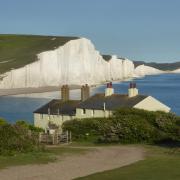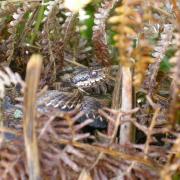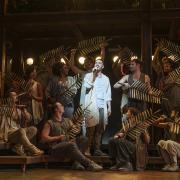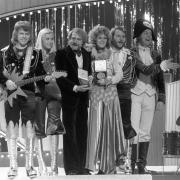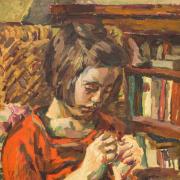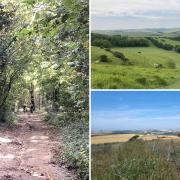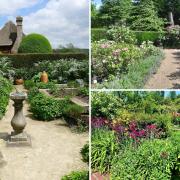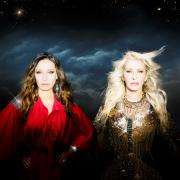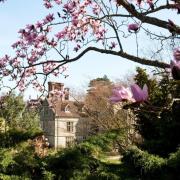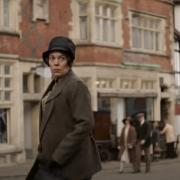Bexhill artist Louise Kenward has travelled the world, visiting towns of the same name as far afield as Australia and Canada. Paul Davis caught up with her to hear all about it

more than a year after leaving Bexhill in East Sussex to travel – as far as possible, by train – to Bexhill in Australia and Bexhill in Canada, Louise Kenward, an installation artist, has returned home.
“The intention behind my journey was to make connections and links between the three Bexhills. It was to see what unifies us and the things we share around the globe, irrespective of culture, creed, race or language.” New experiences began on her way to Ashford. “I discovered the Marshlink, a beautiful rail journey along the shoreline, and then up into marshes and wilderness.”
Louise’s art installation encircles the globe: “Trail of Breadcrumbs is an ongoing series of small scale works plotting my journey around the world. Temporary, transient pieces placed at regular intervals as in Hansel and Gretel. Pebbles are collected and covered in crochet before being replaced. Emerging from the desire to make work as I travelled between places called Bexhill, this became a great way of meeting people and inviting comment.”
Accompanied by her copies of Annie Brassey’s A Voyage in the Sunbeam (1878) and Lillias Campbell Davidson’s Hints to Lady Travellers (1889), Louise recalls “the influence of women on my trip cannot go without comment. Annie, whose eclectic collection is housed in Bexhill Museum, is a huge influence, as is Kate Marsden (who left England with only ‘a fur coat and a whistle’), who also came from Bexhill. “I tried, unsuccessfully, to find traces of Kate and her quest for a cure for leprosy while travelling through Siberia, but she remains present in her connection with the museum.”

The longest single train journey Louise experienced was on the Trans-Siberian Railway, where she spent five days “bartering and sharing goods, trading information about timetables, and platform stops, and sharing in the delight at discovering there was toilet roll and hand towels!” She travelled on through China before arriving in Hong Kong: “I was treading in Annie’s footsteps and following up a mission from Bexhill Museum. Annie’s Hong Kong (formerly Victoria) was entirely mountainous; Victoria Harbour remains, albeit a bit further out to sea than it was in 1877. Another link with Bexhill is the statue of Queen Victoria, which was made in Pimlico by a founder of the museum, and which I was duly sent to look for. She has had an eventful time having been relocated from Statue Square, painted red as an act of protest, and ending up at the entrance to Victoria Park, hopefully there to remain.”
Louise journeyed through South-East Asia and Indonesia before arriving in Bexhill, Australia. The town used to be called Beck’s Hill and “has nothing to do with early English settlers from Sussex. Originally known as ‘Bald Hill’, the surveyor, Mr Ewing, recruited a Mr Beck to assist him for a time. Mr Beck must have been particularly good at assisting!” The town developed through the logging industry and, when no cedar trees remained, became a centre for the dairy industry. Louise worked with TarpSpace, a critically-acclaimed travelling art project and, having made a crochet cover from a torn tarpaulin for an old brick, replaced it at the town’s abandoned brickworks. A smaller ‘breadcrumb’ was created for protest group The Knitting Nanas, “who successfully stood against drilling for coal seam gas a short distance from Bexhill. They, and many others, have subsequently participated in an exhibition of art works relating to Bentley and the ‘Lock the Gate’ campaign. They included the pebble I gave them.”
The next stop was Bexhill, Canada, little of which remains. It was originally created because of a grain elevator (the name was just the next one on Canadian Railway’s methodical list of stations) and, as with the other Bexhills, the railway was the key. Surrounded by farms, the small settlement faded away after the elevator – which also served as a community hub – closed in 1976.
Louise is now artist-in-residence at Bexhill Museum (www.bexhillmuseum.co.uk). Thanks to a recent £10,000 grant from the Heritage Lottery Fund, she plans to develop a “dialogue with local heritage”. It is entitled In conversation with Annie and is based on her travels, in an innovative exhibition at the museum. She also intends to continue to develop links between the three Bexhills – especially through the oral history project she carried out in Australia and Canada, which she hopes to continue in East Sussex.
Louise’s further artistic adventures can be followed at www.bexhilltobexhill.com

***
READ ON
• New BBC drama Life in Squares - on set at Charleston - Life in Squares, a BBC drama based on the lives of Virginia Woolf and Vanessa Bell, will come to our screens this summer. Jenny Mark-Bell visited the set at Charleston, near Firle, to speak to the actors
• 20 stunning photos of Sussex on Instagram - A quick search for #Sussex on Instagram gives you an abundance of amazing pictures of our beautiful county. Here are a selection of some of the very best we found...




